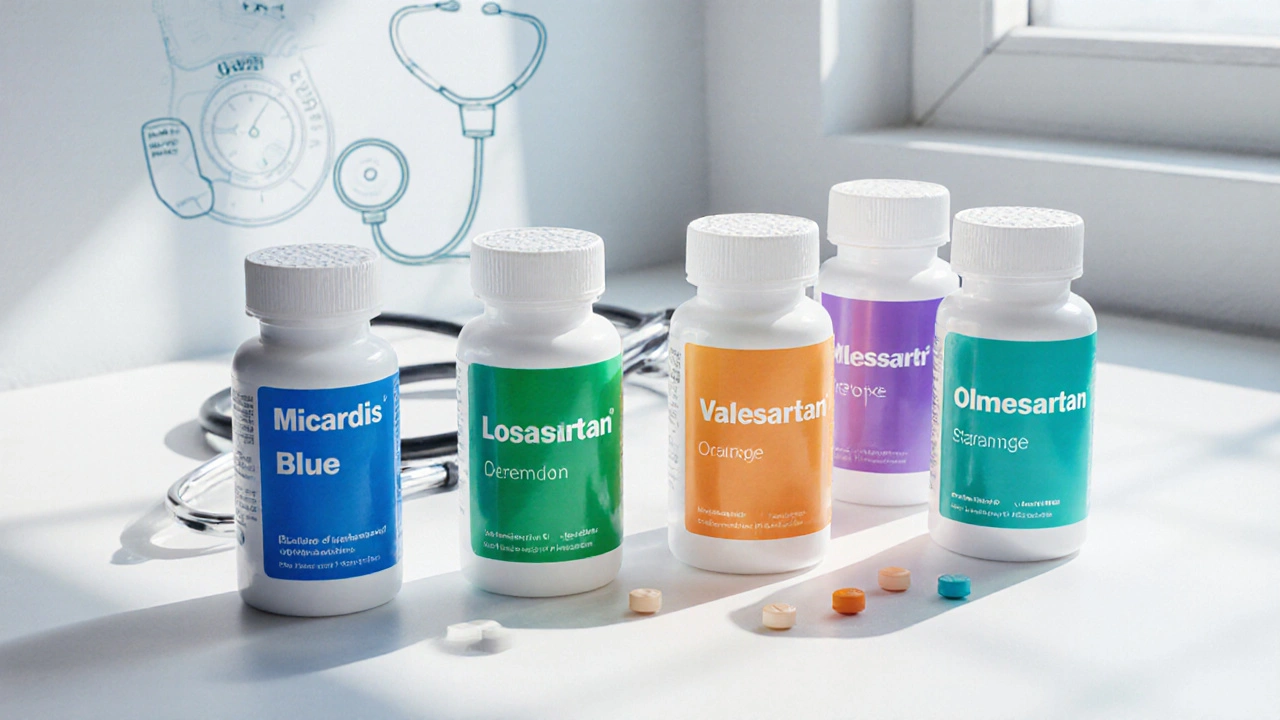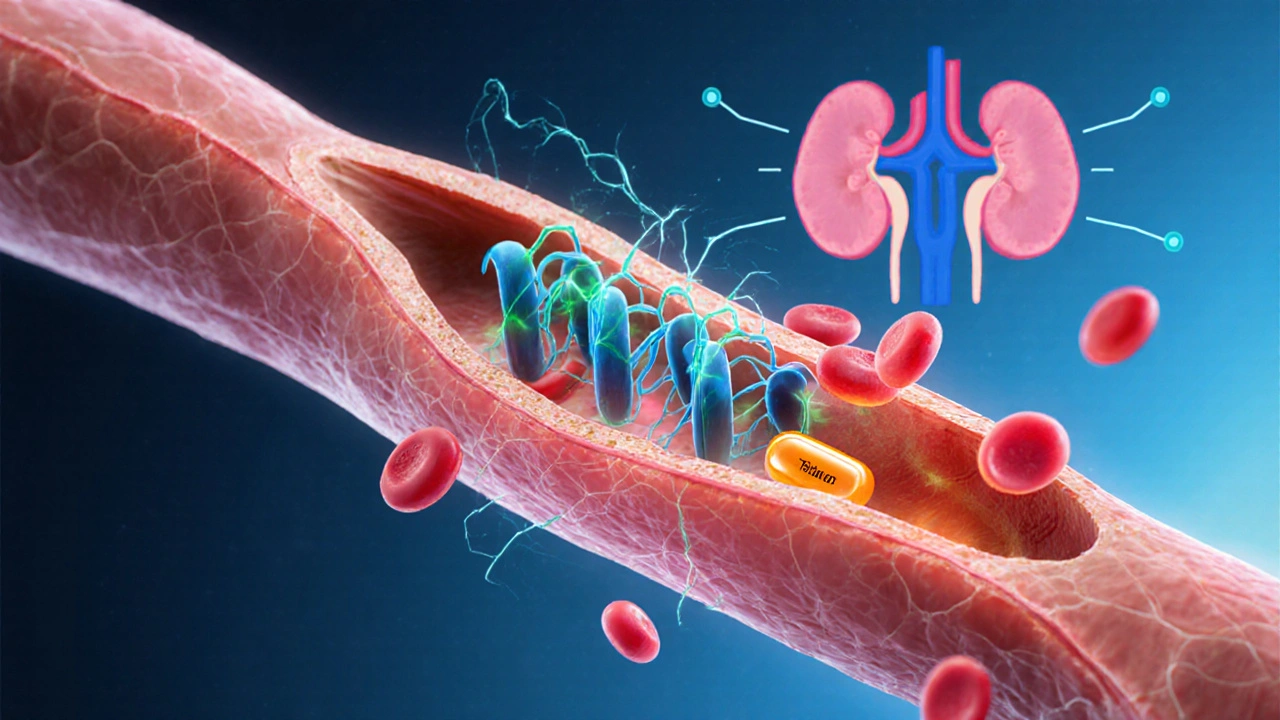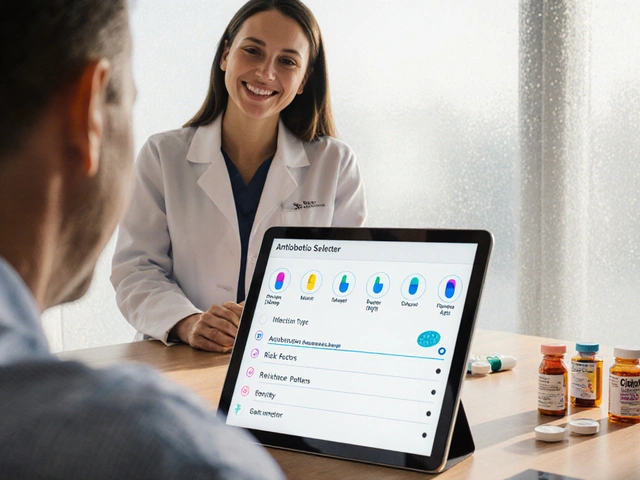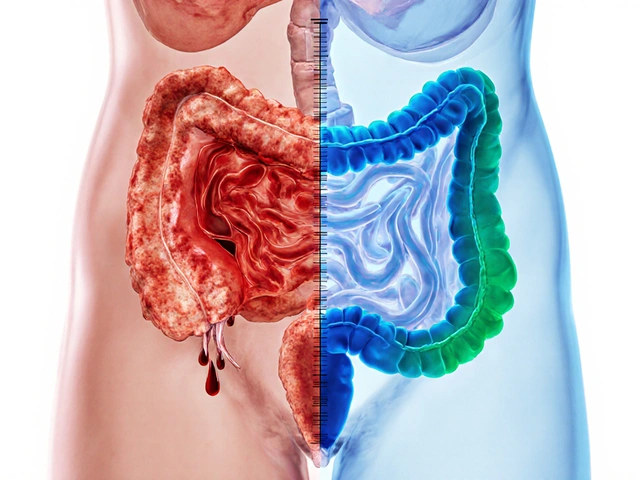
Micardis vs Other ARBs: Drug Comparison Tool
Micardis (Telmisartan)
Special Benefits: Renal-cardio protection, PPAR-γ activity
Half-Life: ~24 hours
Dosage: 40-80 mg daily
Cost: $90 (brand)
Losartan
Special Benefits: Uric-acid lowering, stroke prevention
Half-Life: ~2 hours (active metabolite 6-8 hours)
Dosage: 50 mg (titrated to 100 mg)
Cost: $12 (generic)
Valsartan
Special Benefits: Heart-failure benefits
Half-Life: ~6 hours
Dosage: 80 mg (up to 320 mg)
Cost: $15 (generic)
Irbesartan
Special Benefits: Kidney-protective in diabetics
Half-Life: ~11 hours
Dosage: 150 mg (up to 300 mg)
Cost: $22 (generic)
Olmesartan
Special Benefits: Strong BP control, low dose needed
Half-Life: ~13 hours
Dosage: 20 mg (up to 40 mg)
Cost: $28 (generic)
Quick Comparison Table
| Drug (Brand) | Typical Daily Dose | Half-Life | Avg SBP/DBP Drop | Common Side-Effects | 30-Day Cost (USD) | Extra Benefits |
|---|---|---|---|---|---|---|
| Micardis | 40-80 mg | ≈24 h | ≈12/8 mmHg | Dizziness, hyperkalemia | $90 (brand) | Renal-cardio protection, PPAR-γ activity |
| Losartan (generic) | 50 mg (titrated to 100 mg) | ≈2 h (active metabolite 6-8 h) | ≈10/6 mmHg | Dizziness, cough (rare) | $12 | Uric-acid lowering, stroke prevention |
| Valsartan (generic) | 80 mg (up to 320 mg) | ≈6 h | ≈11/7 mmHg | Dizziness, constipation | $15 | Heart-failure benefits |
| Irbesartan (generic) | 150 mg (up to 300 mg) | ≈11 h | ≈11/7 mmHg | Dizziness, fatigue | $22 | Kidney-protective in diabetics |
| Olmesartan (generic) | 20 mg (up to 40 mg) | ≈13 h | ≈12/8 mmHg | Dizziness, rare sprue-like enteropathy | $28 | Strong BP control, low dose needed |
Decision Guide
Use this checklist to determine which ARB might be best for you:
- 1 Do you have diabetes with kidney involvement? - Irbesartan or Micardis
- 2 Is cost the main concern? - Losartan, followed by generic valsartan
- 3 Do you need once-daily dosing? - Micardis, irbesartan, olmesartan, and higher-dose valsartan
- 4 Any history of gout or high uric acid? - Losartan offers added benefit
- 5 Previous intolerance to ARBs? - Try a different molecule
When you or a loved one need to control high blood pressure, the market offers a handful of medicines that belong to the same drug class - the angiotensin II receptor blockers (ARBs). Micardis is the brand name for telmisartan, a once‑daily ARB approved for hypertension, heart failure and diabetic kidney protection. But is it the best fit for you? This guide lines up Micardis against its most common ARB cousins, breaking down efficacy, side‑effects, dosing, price and special considerations so you can decide which pill matches your health goals.
Key Takeaways
- Micardis (telmisartan) provides strong 24‑hour blood‑pressure control and is the only ARB approved for reducing cardiovascular risk in patients with chronic kidney disease.
- Losartan, valsartan, irbesartan and olmesartan all work similarly, but differ in half‑life, dosing frequency and cost.
- Common side‑effects across the class include dizziness, hyperkalemia and rare kidney function changes; individual tolerability varies.
- Generic versions of losartan and valsartan are usually cheaper than brand‑name Micardis, while generic irbesartan and olmesartan sit in the mid‑range.
- Choosing the right ARB depends on your comorbidities (diabetes, kidney disease), drug interactions, and insurance coverage.
What Is Micardis (Telmisartan)?
Telmisartan is a selective antagonist of the angiotensin II type 1 (AT1) receptor. By blocking this receptor, it prevents vasoconstriction and aldosterone release, leading to lower systemic vascular resistance and reduced blood‑pressure levels. Micardis is taken as a 40mg, 80mg or 160mg tablet, usually once daily, because its half‑life (≈24hours) offers round‑the‑clock coverage.
Key attributes:
- Class: Angiotensin II receptor blocker (ARB)
- Typical dose: 40-80mg daily; 160mg for resistant hypertension
- Approval year: 1998 (EU); 2000 (US)
- Special indication: Reduces risk of myocardial infarction, stroke and renal events in patients with type‑2 diabetes and macro‑albuminuria
How ARBs Work and Why They Matter
All ARBs block the same receptor, but subtle differences affect how long they stay active and how they interact with other pathways. For example, telmisartan also has weak partial agonist activity at the peroxisome proliferator‑activated receptor‑γ (PPAR‑γ), which may improve insulin sensitivity-a bonus for diabetics. Most ARBs are neutral elsewhere, so the primary performance drivers become pharmacokinetics (half‑life, bioavailability) and extra‑receptor actions.
Comparison Criteria
To make a fair side‑by‑side look, we’ll score each drug on five factors that patients and doctors commonly weigh:
- Efficacy: Average systolic/diastolic reduction in clinical trials.
- Safety & tolerability: Frequency of dizziness, hyperkalemia, cough, and serious adverse events.
- Convenience: Dosing frequency, need for titration, and food restrictions.
- Cost: Average US retail price for a 30‑day supply (brand vs. generic).
- Special benefits: Renal protection, metabolic effects, or FDA‑approved extra indications.

Quick Reference Table
| Drug (Brand) | Typical Daily Dose | Half‑Life | Avg SBP/DBP Drop | Common Side‑Effects | 30‑Day Cost (USD) | Extra Benefits |
|---|---|---|---|---|---|---|
| Micardis | 40-80mg | ≈24h | ≈12/8mmHg | Dizziness, hyperkalemia | $90 (brand) | Renal‑cardio protection, PPAR‑γ activity |
| Losartan (generic) | 50mg (titrated to 100mg) | ≈2h (active metabolite 6‑8h) | ≈10/6mmHg | Dizziness, cough (rare) | $12 | Uric‑acid lowering, stroke prevention |
| Valsartan (generic) | 80mg (up to 320mg) | ≈6h | ≈11/7mmHg | Dizziness, constipation | $15 | Heart‑failure benefits |
| Irbesartan (generic) | 150mg (up to 300mg) | ≈11h | ≈11/7mmHg | Dizziness, fatigue | $22 | Kidney‑protective in diabetics |
| Olmesartan (generic) | 20mg (up to 40mg) | ≈13h | ≈12/8mmHg | Dizziness, rare sprue‑like enteropathy | $28 | Strong BP control, low dose needed |
Deep Dive: How Each Alternative Stacks Up
Losartan
Losartan Losartan was the first ARB on the US market (1995). Its active metabolite, EXP‑3174, extends the antihypertensive effect, but the parent compound clears quickly, which is why many clinicians start at 50mg and may need twice‑daily dosing for resistant cases. It’s the most cost‑effective ARB, making it a go‑to for patients with limited insurance coverage. Losartan also lowers uric acid, offering a bonus for gout sufferers.
Valsartan
Valsartan Valsartan provides a slightly longer half‑life than losartan, allowing once‑daily dosing at 80mg-320mg. Clinical trials (e.g., VALIANT) showed mortality benefits in post‑myocardial‑infarction patients, which can sway cardiologists. However, it’s marginally pricier than generic losartan, and rare cases of angio‑edema have been reported.
Irbesartan
Irbesartan Irbesartan shines in diabetic kidney disease. The IRMA‑2 study demonstrated a 30% slower progression of micro‑albuminuria compared with placebo. Its half‑life (~11h) means once‑daily dosing is effective, but the pill is bigger, which can be a swallow‑issue for some older adults.
Olmesartan
Olmesartan Olmesartan is the most potent ARB on a per‑milligram basis. The ONTARGET trial showed comparable cardiovascular protection to telmisartan, yet a small subset of patients developed a sprue‑like enteropathy manifesting as chronic diarrhea. Because of this rare side‑effect, clinicians often reserve it for patients who have not responded to other ARBs.
Choosing the Right ARB for You
Here’s a quick decision‑tree you can run through with your prescriber:
- Do you have diabetes with kidney involvement? - Irbesartan or Micardis (telmisartan) are top picks.
- Is cost the main concern? - Losartan is the cheapest, followed by generic valsartan.
- Do you need once‑daily dosing? - Micardis, irbesartan, olmesartan, and higher‑dose valsartan all meet this.
- Any history of gout or high uric acid? - Losartan offers added uric‑acid reduction.
- Previous intolerance to ARBs? - Switch to a different molecule; side‑effects are often molecule‑specific.
Never switch or stop medication without consulting a healthcare professional. Even small dosing changes can affect blood‑pressure control and kidney function.
Frequently Asked Questions
Can I take Micardis with a ACE inhibitor?
Combining an ARB like Micardis with an ACE inhibitor raises the risk of high potassium and kidney injury. Doctors only do it in very specific scenarios, such as after a heart‑failure hospitalization, and they monitor labs closely.
Is telmisartan safe during pregnancy?
No. All ARBs are classified as Pregnancy Category D. They can cause fetal kidney damage and should be stopped as soon as pregnancy is detected.
How long does it take for Micardis to lower blood pressure?
Most patients see a measurable drop within 1‑2 weeks, with the full 24‑hour effect plateauing around 4‑6 weeks.
Are there any food restrictions with telmisartan?
No. Telmisartan can be taken with or without food. However, grapefruit juice can slightly increase its plasma levels, so moderation is advised.
What should I monitor while on an ARB?
Regular checks of blood pressure, serum potassium, and kidney function (creatinine/eGFR) are recommended, especially after starting or changing doses.
Next Steps & Troubleshooting
If you’ve started Micardis and notice persistent dizziness, schedule a lab test within two weeks to rule out high potassium. If labs are normal but symptoms continue, your doctor may try lowering the dose or switching to a shorter‑acting ARB like losartan. For patients who can’t tolerate any ARB, alternative classes (ACE inhibitors, calcium‑channel blockers, or thiazide diuretics) become viable options.
Always keep an up‑to‑date medication list handy, especially when seeing new specialists, to avoid accidental duplication of ARBs with other blood‑pressure agents.




1 Comments
Wow, what a comprehensive breakdown! 😊 It’s great to see all the options laid out so clearly.